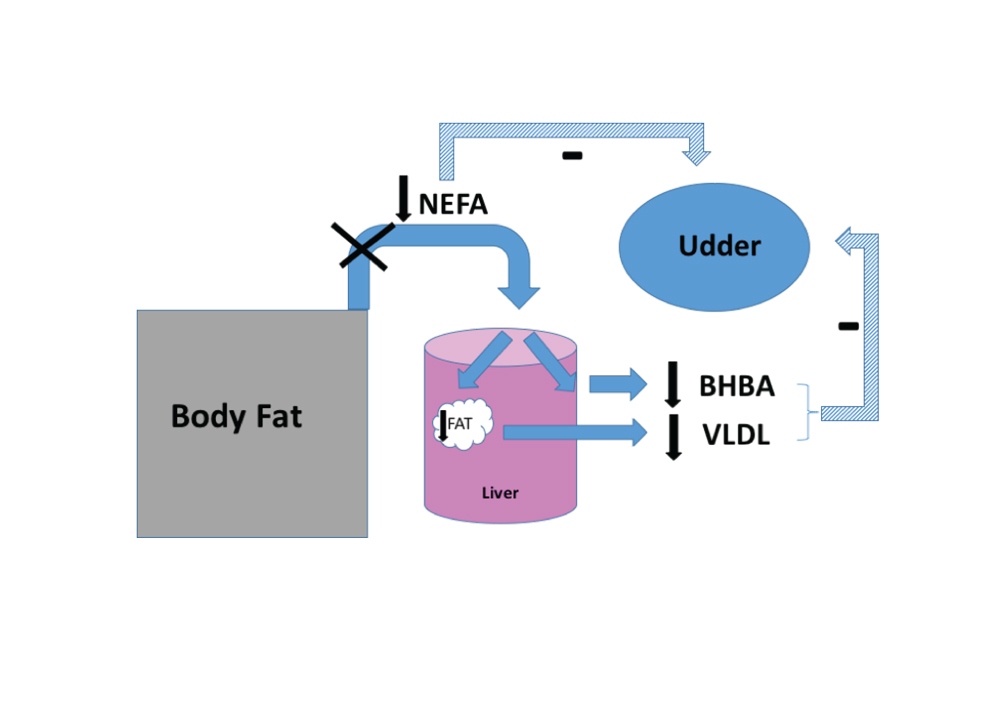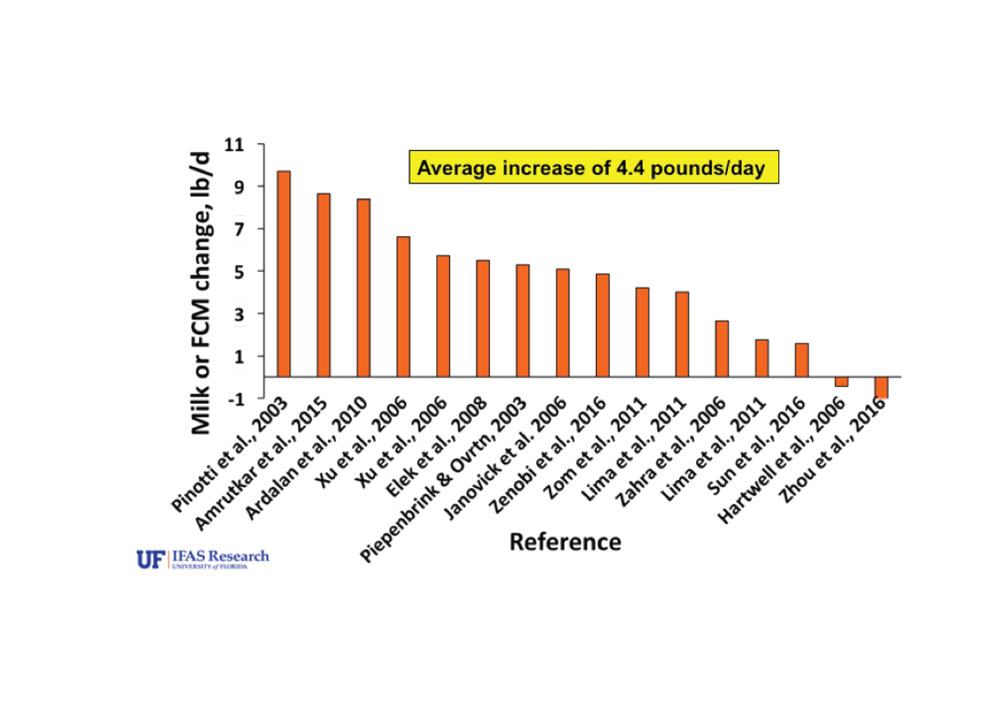Over the years, researchers have amassed substantial evidence linking elevated levels of nonesterified fatty acids (NEFA) and beta-hydroxybutyrate (BHBA) with adverse outcomes in dairy cows. This has prompted numerous large-scale epidemiological studies aimed at pinpointing the critical blood concentrations where these negative effects might manifest in transition cows. Given that BHBA is much more frequently measured than NEFA, it has become the focal point of many of these investigations. These studies consistently suggest that a blood concentration of 1.2–1.4 mmol BHBA/L is the threshold where milk production tends to decline. As a result, it's commonly recommended that if 10–15% or more of the cows tested exceed this threshold, an alarm should be raised, and the underlying causes should be investigated.
---
In the previous myth-busting article, we explored the widespread belief within the dairy industry that the rise in blood NEFA and BHBA levels in transition cows is inherently harmful. We debunked this myth by explaining that these compounds are not always detrimental and can even support lactation by acting as precursors for milk fat synthesis and energy sources for milk production. However, there are instances when these levels can spike excessively, leading to negative consequences for the cow. Traditionally, the approach to addressing this issue has been to administer feed additives or treatments that target fat tissue to limit fat mobilization and reduce NEFA levels entering the bloodstream and subsequently reaching the liver (see Figure 1).
---

**Figure 1: Traditional approach to managing fat mobilization, which restricts nutrient availability to the udder for milk production.**
---
Dr. John Newbold succinctly captured the potential downside of this conventional method:
“The nutritional restriction of adipose tissue mobilization might be necessary, but there’s a philosophical issue here. We’ve bred cows that rely heavily on mobilized body reserves for milk production. The farmer has essentially paid the geneticist for this—should we now ask the nutritionist to counteract it? Our priorities are misplaced. Instead of trying to reduce the amount of fatty acids supplied to the liver, we should first consider how we can help the liver handle these fatty acids.â€
Dr. Newbold’s innovative approach to fat mobilization management is illustrated in Figure 2, contrasting it with the historical approach depicted in Figure 1. His strategy involves using the liver to channel NEFA into the mammary gland via very low-density lipoproteins (VLDL), preventing fat storage in the liver or its conversion to BHBA. In essence, his aim is to help cows avoid fatty liver and ketosis while sidestepping related complications.
---

**Figure 2: Improved approach to managing fat mobilization by supporting fat export from the liver to the udder through rumen-protected choline.**
---
The key takeaway here is that the initial step in managing fat mobilization should be aiding the liver. The only known compound capable of achieving this is choline. Although dietary choline is essential, it is often degraded in the rumen. Thus, it needs to be supplemented in a rumen-protected form. Choline works by enhancing phosphatidylcholine synthesis, which is crucial for VLDL assembly and fat export from the liver (Chandler et al., 2017). Multiple studies demonstrate that supplementing rumen-protected choline reduces fat accumulation during intense NEFA mobilization in dry or transition cows (Cooke et al., 2007; Zom et al., 2011; Elek et al., 2013). As Dr. Newbold suggests, choline supports lactation without curtailing nutrient availability to the mammary gland. Two summaries of transition cow trials indicate that feeding rumen-protected choline boosts milk production by 4.9 pounds per day (Grummer, 2012) or 4.4 pounds daily (Staples, unpublished, see Figure 3).
---

**Figure 3: Summary of milk yield responses when feeding rumen-protected choline to transition dairy cows.**
---
**Sources:**
- CHANDLER, T. L. AND H. M. WHITE. 2017. *Choline and methionine differentially alter methyl carbon metabolism in bovine neonatal hepatocytes.* PLOS ONE, doi.org/10.1371/journal.pone.0171080.
- COOKE, R. F., N. SILVA DEL RIO, D. Z. CARAVIELLO, S. J. BERTICS, M. H. RAMOS, AND R. R. GRUMMER. 2007. *Supplemental choline for prevention and alleviation of fatty liver in dairy cattle.* Journal of Dairy Science, 90: 2413-2418.
- ELEK, P., T. GAAL, AND F. HUSVETH. 2013. *Influence of rumen-protected choline on liver composition and blood variables indicating energy balance in periparturient dairy cows.* Acta Veterinaria Hungarica, 61:59-70.
- GRUMMER, R. R. 2012. *Choline: A limiting nutrient for transition dairy cows.* Proceedings of the Cornell Nutrition Conference.
- JANOVICK, N. A., AND J. K. DRACKLEY. 2010. *Prepartum dietary management of energy intake affects postpartum intake and lactation performance by primiparous and multiparous Holstein cows.* Journal of Dairy Science, 93:3086-3102.
- MCNAMARA, J. P., AND F. VALDEZ. 2005. *Adipose tissue metabolism and production responses to calcium propionate and chromium propionate.* Journal of Dairy Science, 88:2498-2507.
- NEWBOLD, J. 2005. *Liver Function in dairy cows.* Pages 257-270 in *Recent Advances in Animal Nutrition,* edited by P. C. Garnsworthy and J. Wiseman. Nottingham University Press.
- YUAN, K., R. D. SHAVER, S. J. BERTICS, M. ESPINEIRA, AND R. R. GRUMMER. 2012. *Effect of rumen-protected niacin on lipid metabolism, oxidative stress, and performance of transition dairy cows.* Journal of Dairy Science, 95:2673-2679.
- ZOM, R. L. G., J. VAN BAAL, R. M. A. GOSELINK, J. A. BAKKER, M. J. DE VETH, AND A. M. VAN VUUREN. 2011. *Effect of rumen-protected choline on performance, blood metabolites, and hepatic triacylglycerols of periparturient dairy cattle.* Journal of Dairy Science, 94:4016-4027.
---
**Related Posts:**
- **Myth #6:** If You Are Feeding Rumen-Protected Methionine, You Do Not Have to Feed Rumen-Protected Choline
Choline and methionine are both available in rumen-protected forms. Despite sharing similarities, they serve distinct roles in ruminants. Understanding their differences is crucial for optimizing dairy cow nutrition.
- **Myth #5:** If You Are Feeding Goldilocks Diets, You Do Not Have to Feed Rumen-Protected Choline
While Goldilocks diets are beneficial for reducing excessive fat mobilization, they don’t eliminate the need for rumen-protected choline. This nutrient plays a vital role in maintaining liver function and overall metabolic health during the transition period.
---
This new perspective on managing fat mobilization offers a promising way forward for dairy farmers looking to optimize productivity and animal welfare.
Gummy Jelly,Center Filled Gummy Candy,Center Filled Jelly Gummy Candy,Collagen Center Filled Gummy Candy
Montreal Shantou Food Co., Ltd , https://www.montrealsnack.com